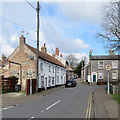1
Thetford: listed buildings on St Nicholas Street
Grade II listed nineteenth-century brick-and-flint houses, the flint frontage of the pair on the left painted.
Image: © John Sutton
Taken: 6 Mar 2020
0.00 miles
2
Thetford houses [2]
Numbers 37 and 39 St Nicholas Street are a pair of mid 19th century houses, probably with an earlier core as suggested by the irregular bays. Built in flint with gault brick dressings with the near gable being rebuilt in brick. Number 37 had a shop front which has been removed. Listed, grade II, with details at: https://historicengland.org.uk/listing/the-list/list-entry/1196084
Once the ancient capital of East Anglia, Thetford is a market town established at a crossing of the River Little Ouse. A major centre of Boudica’s Iceni tribe and there is an Iron Age fort. Later came a Norman castle and an important priory. Thetford is the birthplace of 18th century radical Thomas Paine, whose thinking encouraged American independence and the abolition of slavery. After World War II, Thetford became an "overspill town", taking people from London.
Image: © Michael Dibb
Taken: 8 Sep 2020
0.01 miles
3
Thetford houses [3]
Numbers 62 and 64 St Nicholas Street are a pair of houses, built circa 1820 in flint with gault brick dressings and a little clunch. Listed, grade II, with details at: https://historicengland.org.uk/listing/the-list/list-entry/1219185
Once the ancient capital of East Anglia, Thetford is a market town established at a crossing of the River Little Ouse. A major centre of Boudica’s Iceni tribe and there is an Iron Age fort. Later came a Norman castle and an important priory. Thetford is the birthplace of 18th century radical Thomas Paine, whose thinking encouraged American independence and the abolition of slavery. After World War II, Thetford became an "overspill town", taking people from London.
Image: © Michael Dibb
Taken: 8 Sep 2020
0.01 miles
4
Thetford: Abbey Green
Looking towards St Nicholas Street.
Image: © John Sutton
Taken: 6 Mar 2020
0.01 miles
5
Thetford: painted flint and rusty iron
Looking down Miller's Lane past Abbey Garage to the Grade II listed houses shown in
Image
Image: © John Sutton
Taken: 6 Mar 2020
0.02 miles
6
Thetford houses [4]
Number 22 Miller's Lane is a house in flint with gault brick dressings dated 1831 on the gable end. Listed, grade II, with details at: https://historicengland.org.uk/listing/the-list/list-entry/1297896
Once the ancient capital of East Anglia, Thetford is a market town established at a crossing of the River Little Ouse. A major centre of Boudica’s Iceni tribe and there is an Iron Age fort. Later came a Norman castle and an important priory. Thetford is the birthplace of 18th century radical Thomas Paine, whose thinking encouraged American independence and the abolition of slavery. After World War II, Thetford became an "overspill town", taking people from London.
Image: © Michael Dibb
Taken: 8 Sep 2020
0.02 miles
7
Thetford houses [1]
Numbers 13 and 15 Water Lane are a pair of late 18th century houses in flint with gault brick dressings. The houses were restored in 1984 at which time the eaves were rebuilt and raised. Listed, grade II, with details at: https://historicengland.org.uk/listing/the-list/list-entry/1196089
Once the ancient capital of East Anglia, Thetford is a market town established at a crossing of the River Little Ouse. A major centre of Boudica’s Iceni tribe and there is an Iron Age fort. Later came a Norman castle and an important priory. Thetford is the birthplace of 18th century radical Thomas Paine, whose thinking encouraged American independence and the abolition of slavery. After World War II, Thetford became an "overspill town", taking people from London.
Image: © Michael Dibb
Taken: 8 Sep 2020
0.02 miles
8
Thetford: up St Nicholas Street
Flint houses in a cul-de-sac north-west of the town centre.
Image: © John Sutton
Taken: 6 Mar 2020
0.03 miles
9
London Road, Thetford
Image: © David Howard
Taken: 18 Apr 2021
0.05 miles
10
London Road, Thetford
Image: © David Howard
Taken: 17 Apr 2022
0.05 miles



![Thetford houses [2]](https://s0.geograph.org.uk/geophotos/06/71/32/6713224_e6a16346_120x120.jpg)
![Thetford houses [3]](https://s2.geograph.org.uk/geophotos/06/71/32/6713226_dd25034c_120x120.jpg)


![Thetford houses [4]](https://s2.geograph.org.uk/geophotos/06/71/32/6713230_9f8eeff9_120x120.jpg)
![Thetford houses [1]](https://s3.geograph.org.uk/geophotos/06/71/32/6713223_3d93fca3_120x120.jpg)


